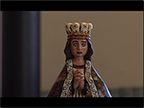During the seventeenth-century, Spanish Franciscan friars in New Mexico imported religious oil paintings, popular prints, and a limited number of sculptures from Europe and Mexico to adorn the newly built missions. Early New Mexican images of devotion reflected the same subjects and iconography as their Mexican colonial counterparts from Spanish traditions.
Following the re-colonization of New Mexico, Fray Andrés García, Bernardo Miera y Pacheco, and an artist known only as the Eighteenth-Century Novice were among the first generation of santeros (saint makers), active from about 1750-1790. Migrating from southern New Spain, they are considered prototypes for later New Mexican-born artists. By 1800, the "classical" period of santero art had begun in the remote villages of northern New Mexico and a distinctive art of devotion developed. Although colonists were geographically distant from the urban centers of Mexico, contact was maintained but often goods beyond bare necessities were limited. As a result, local artisans began to carve and paint images of saints, known as santos, to meet the needs for personal devotional objects and church adornment.
Shifting from the original European and Mexican sources, artists created a local version of the baroque style by the late eighteenth-century. Mostly self-taught artists, they used the same pine, aspen, and cottonwood root as that used by Native Americans. Pigments for painting combined mineral and plant pigments used by Pueblo Indians with imported European or Mexican oil paint. Santeros also adopted the practice of a tanned buckskin as a painting surface to create images of saints on hide.


